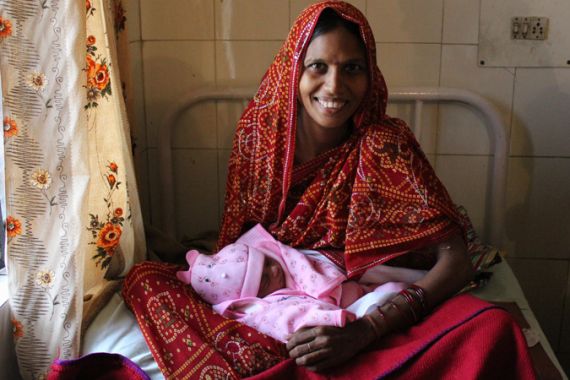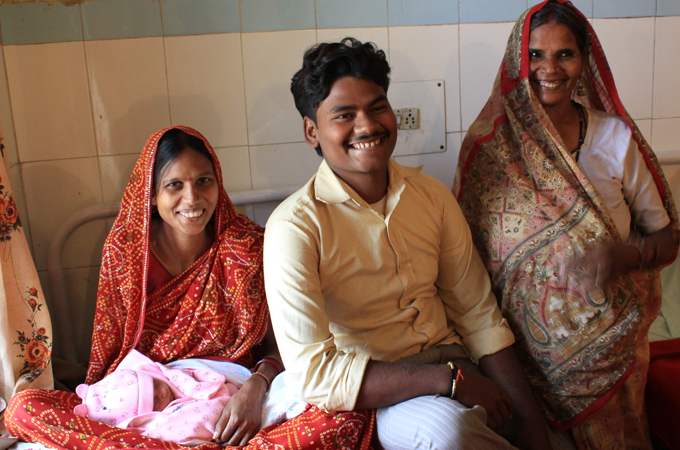UN: World population reaches seven billion
World body says demographic milestone has now been reached, as communities across the globe honour symbolic newborns.

 |
| Baby Nargis was born at 07:25 in Mall village outside Lucknow in India’s Uttar Pradesh state [Plan/Davinder Kumar] |
The UN has estimated that the world’s population reached seven billion people on Monday.
Countries around the world marked the occasion with lavish ceremonies for newborn infants symbolizing the milestone, as well as warnings that there may be too many humans for the planet’s resources.
A string of festivities are being held worldwide, with a series of symbolic seven-billionth babies being born.
The celebrations began in the Philippines, as Danica May Camacho came into the world at two minutes before midnight, a tiny, wrinkled girl born into a struggling Manila family.
Born in the crowded Jose Fabella Memorial Hospital, Danica was welcomed with a chocolate cake marked “7B Philippines” and a gift certificate for free shoes.
There were bursts of photographers’ flashes, and speeches by local officials.
Amid the millions of births and deaths around the world each day, it is impossible to pinpoint the arrival of the globe’s seven-billionth occupant.
Speaking on Monday, Ban Ki-moon, the UN secretary-general, said: “Our world is one of terrible contradictions. Plenty of food but one billion people go hungry. Lavish lifestyles for a few, but poverty for too many others.”
He asked rhetorically, “What kind of world has baby seven billion been born into?”
“She looks so lovely,” Danica’s mother, Camille Galura, whispered as she cradled the 2.5kg baby, who was born about a month premature.
The baby was the second for Galura and her partner, Florante Camacho, a driver who supports the family on a tiny salary driving a “jeepney”, a ubiquitous jeep-like bus used by many poor and working-class Filipinos.
‘Population explosion’
Dr Eric Tayag of the Philippines’ Department of Health said the symbolic birth came with a warning.
“Seven billion is a number we should think about deeply,” he said.
“We should really focus on the question of whether there will be food, clean water, shelter, education and a decent life for every child,” he said.
“If the answer is ‘no’, it would be better for people to look at easing this population explosion.”
In the Philippines, much of the population question revolves around birth control.
The government backs a programme that includes artificial birth control but the powerful Roman Catholic church vehemently opposes contraception.
Camacho, a Catholic like her husband, said she was aware of the church’s position but had decided to begin using birth control.
“The number of homeless children I see on the streets keeps multiplying,” Camacho said. “When I see them, I’m bothered because I eat and maybe they don’t.”
Growing, fast
Demographers say it took until 1804 for the world to reach its first billion people, and a century more until it hit two billion in 1927.
During the 20th century there was a dramatic increase: Three billion in 1959; four billion in 1974; five billion in 1987; six billion in 1998.
| In Video |
|
Nilanjan Chowdhury reports from North India |
The UN estimates the world’s population will reach eight billion by 2025 and 10 billion by 2083. But the numbers could vary widely, depending on everything from life expectancy, to access to birth control, to infant mortality rates.
In Uttar Pradesh, India – the most populous state in the world’s second-most populous country – officials said they would appoint seven girls born on Monday to symbolise the seven billion.
Among the new-born girls was Nargis, born to Ajay and Vinita Yadav.
Her father said: “I am very happy that my daughter is a special baby and I will ensure that she will make something of herself when she grows up.”
India, which struggles with a deeply held preference for sons and a skewed sex ratio because of millions of aborted female fetuses, is using the day to highlight that issue.
“It would be a fitting moment if the seven billionth baby is a girl born in rural India,” said Dr. Madhu Gupta, an Uttar Pradesh gynecologist. “It would help in bringing the global focus back on girls, who are subject to inequality and bias.”
According to US government estimates, India has 893 girls for every 1,000 boys at birth, compared with 955 girls per 1,000 boys in the US.
On Monday, the chosen Indian babies were being born at the government-run Community Health Centre in the town of Mall, on the outskirts of the Uttar Pradesh capital of Lucknow.
Six babies were born from midnight to 8 am on Monday and four were boys.
Skewed sex ratio
China, meanwhile, which at 1.34 billion people is the world’s most populous nation, said it would stand by its one-child policy, a set of restrictions launched three decades ago limiting most urban families to one child and most rural families to two.
“Overpopulation remains one of the major challenges to social and economic development,” Li Bin, director of the State Population and Family Planning Commission, told the official Xinhua News Agency.
Click for Baby 7 Billion photo gallery |
Li said the population of China would hit 1.45 billion in 2020.
While the Beijing government says its strict family planning policy has helped propel the country’s rapidly growing economy, it has also brought many problems.
Soon, demographers say, there will not be enough young Chinese to support its enormous elderly population.
China, like India, also has a highly skewed sex ratio, with aid groups saying sex-selective abortions have resulted in an estimated 43 million fewer girls than there should be, given the overall population.
India, with 1.2 billion people, is expected to overtake China around 2030, when the Indian population reaches an estimated 1.6 billion.
